Can you jump start a Tesla? This question might come up if you’ve had your Tesla for a few years, as its 12-volt battery, which powers things like the locks and lights, generally lasts about 3-5 years. If it dies, this is the one needing a jump, not the main battery! Explore whether Tesla vehicles can jump-start cars in Can a Tesla Jump Start a Car?
Jump-starting a Tesla is unlike traditional cars because we’re simply recharging the 12V system for basic access and functions. Rather than “starting the engine,” this jump merely enables essential features to get you safely to a charging station.
Can a Tesla Jump Start Another Car?
Yes, technically, a Tesla can jump-start another car, but it’s not recommended. Traditional internal combustion engine (ICE) vehicles need a high amperage, usually around 300-700 amps, which Tesla’s 12V auxiliary battery isn’t built to provide safely.
Attempting this could strain or even damage Tesla’s DC/DC converter and its 12V battery system, which isn’t covered for jump-starting other vehicles. Instead, Tesla advises using an external lithium-ion jump starter if you need to help another car. See how AVAPOW products perform in our detailed AVAPOW Jump Starter Reviews
A Closer Look at Tesla’s Unique Dual Battery Setup
Let’s get into what makes a Tesla’s battery system different. Tesla actually has two batteries onboard: the main high-voltage battery (around 400 volts) and a smaller 12V auxiliary battery. The high-voltage battery powers the motor, while the 12V battery runs essential functions like lights, displays, and locks.
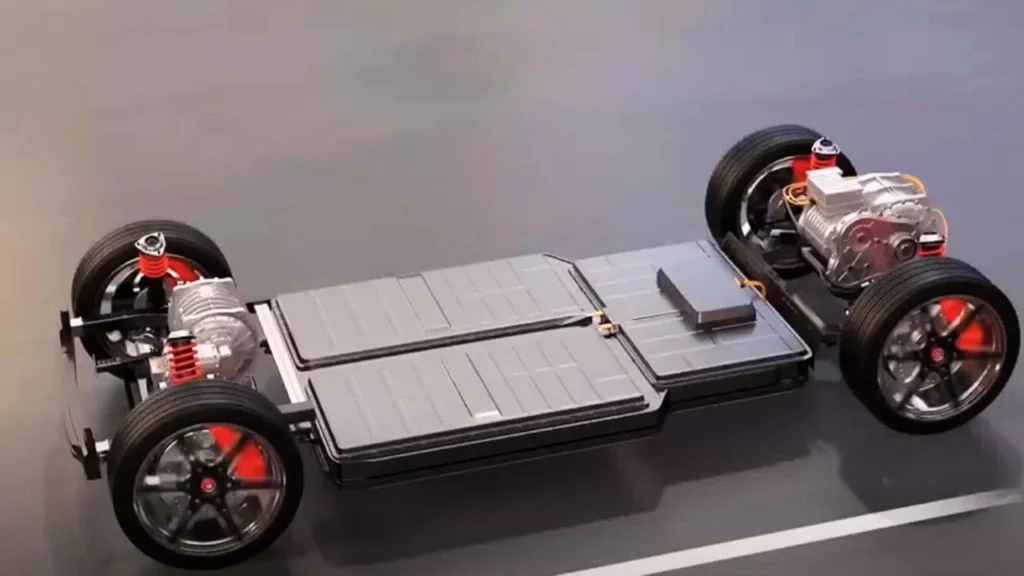
Now, unlike gas-powered cars, which rely on a single battery to kickstart the engine, Tesla’s main battery doesn’t handle these low-voltage tasks. Instead, the 12V battery takes on this role, which can be surprising if you’re used to traditional setups. This setup ensures that even when the main battery is low, the 12V system can keep essential functions active.
In Teslas, the 12V battery lifespan averages around three to five years, but it can vary based on usage and climate. If it fails, the car won’t start even if the main battery is fully charged. That’s why Tesla has added alerts for drivers, giving you about two weeks’ notice to replace the battery when it’s low. Find out if jump starters can also charge car batteries in Can a Jump Starter Charge a Battery?
When Might You Need to Jump Start a Tesla?
A Quick Reality Check on the 12V Battery
Imagine that you’re all set for a trip, but your Tesla’s 12V battery is out of charge! In most cases, the Tesla won’t need a jump start unless this smaller battery runs low, not the main battery that powers the car. For reference, the 12V battery supports essentials like lights, locks, and displays, keeping things functional even when parked.
Battery Life and Typical Lifespan
Tesla’s 12V battery can typically last around 2-5 years, though this varies based on your car’s usage and conditions. For those long road trips or if you leave the car parked for weeks, the 12V can deplete faster, especially in colder climates where batteries tend to lose power quicker.
Advance Warning for a Low 12V Battery
Thankfully, Teslas are smart enough to notify you when the 12V battery starts to fail—often two weeks ahead! This notification gives you time to replace it before you’re stranded. So, if you see that alert, it’s your cue to get ready, either by replacing the battery or having a jump-starter handy. Learn about dual-function devices in Jump Starter and Power Bank
Step-by-Step Guide: Can You Jump Start a Tesla?
Jump-starting a Tesla’s 12V battery is straightforward, but safety is key. With a reliable lithium-ion jump starter, a few easy steps can revive your Tesla when needed. Here’s how to safely bring your car back to life, one step at a time.
Step 1: Gather the Necessary Tools
Make sure you have an external lithium-ion jump starter with a voltage of around 10 to 20 volts. This device is specifically designed for a Tesla’s 12V battery and is safer than using another vehicle.

Step 2: Locate the Tow Eye Cover
Find the round tow eye cover on the driver’s side of your Tesla’s front bumper. Press on the top-right corner to loosen it, then gently pull it away to expose the jump-starting connections (positive and negative wires).
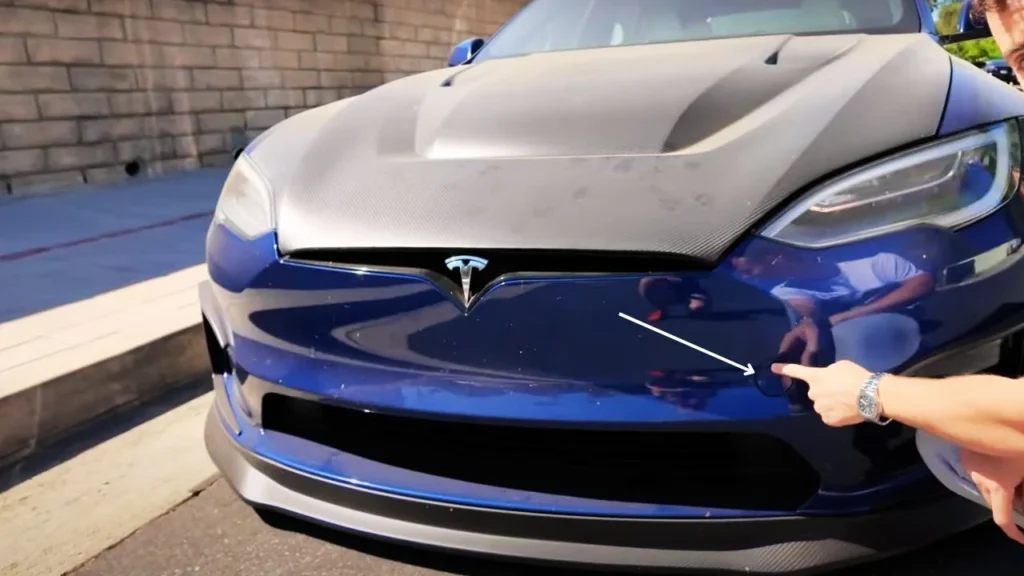
Step 3: Attach the Jump Starter Cables
Connect the red cable of your jump starter to Tesla’s red (positive) wire and the black cable to the black (negative) wire. Be sure to connect “red first, then black” to prevent electrical issues.
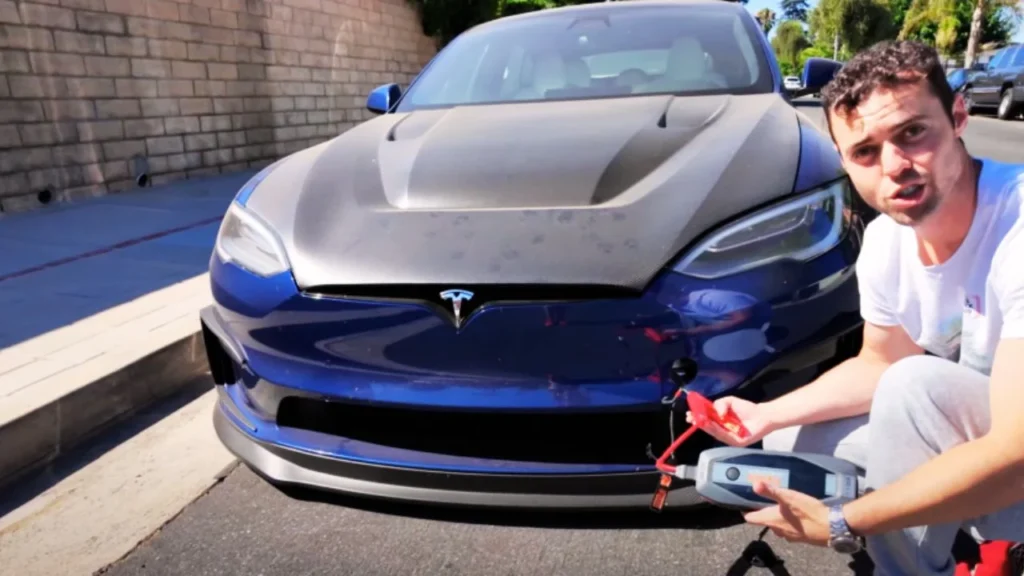
Step 4: Power Up the Jump Starter
Turn on your external jump starter for about 10 to 15 seconds to supply a small charge to the 12V battery. This short charge should be enough to unlock the frunk automatically, allowing access to the main battery.
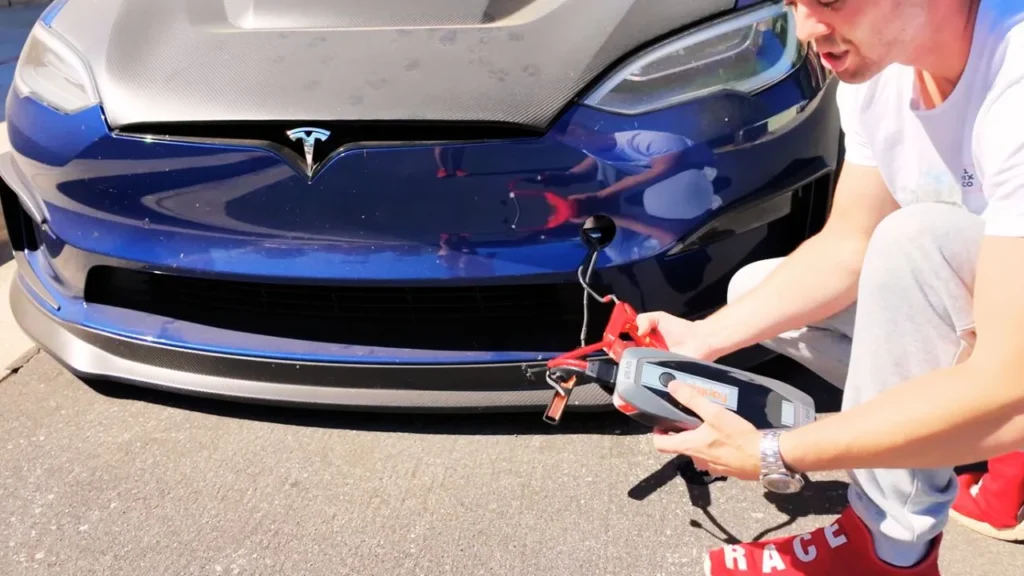
Step 5: Disconnect the Jump Starter
Once the front trunk (frunk) unlocks, turn off the jump starter and carefully remove the cables in the reverse order (black first, then red). This ensures safety and protects the Tesla’s electrical system.
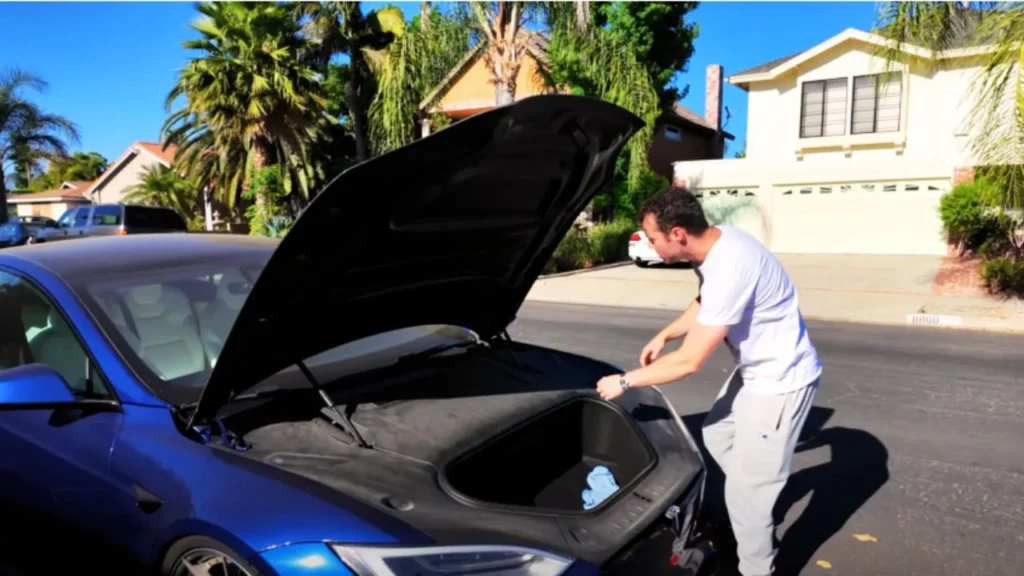
Step 6: Access the 12V Battery
With the frunk open, remove the black plastic cover above the battery compartment by lifting it up. The cover is held by around 12 clips, which you can easily pop off by hand without any tools.

Step 7: Connect the Jump Starter to the 12V Battery
Attach the red cable from the jump starter to the 12V battery’s red terminal and the black cable to the black terminal. Following the same “red first, then black” rule is crucial for safe charging.

Step 8: Recharge the Battery
Power on the jump starter and let it run for about 10 minutes. Watch for signs of activity on the Tesla’s touchscreen; once it lights up, the battery should be sufficiently recharged to start up your car.
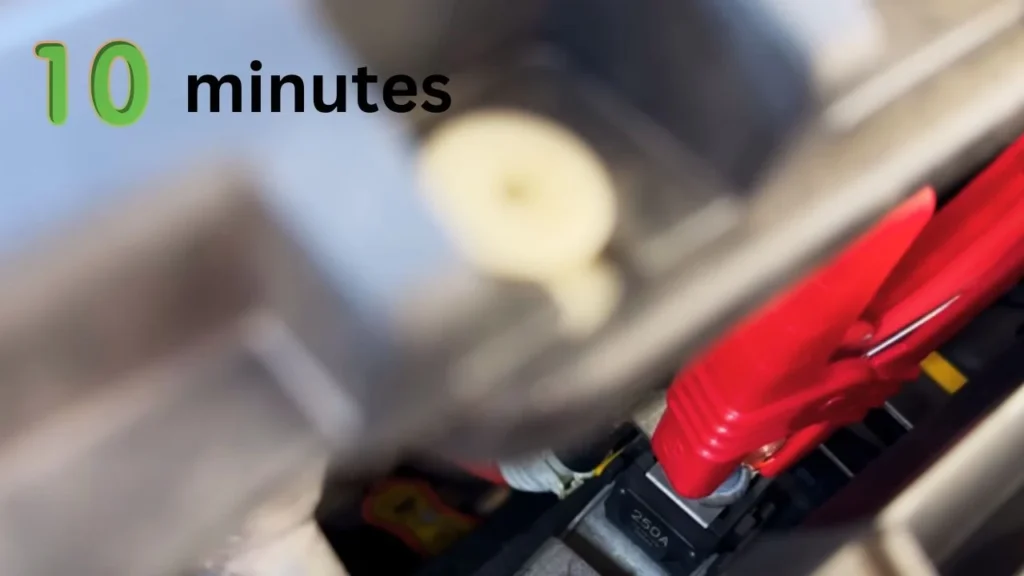
Step 9: Disconnect and Reassemble
Turn off the jump starter, disconnect the cables (black first, then red), and put the black plastic cover back in place. Ensure all clips are aligned and securely press the cover into position before closing the frunk

Post-Jump Start Steps
After jump-starting your Tesla, allow a smooth recovery for the 12V battery. A 15-20 minute drive will help stabilize the charge, and it’s wise to check the range—if there’s a 5-10% drop, a service check may be needed. To avoid extra strain, limit high-power activities like heavy AC and rapid acceleration right afterward, letting the battery settle back into its usual cycle gradually.
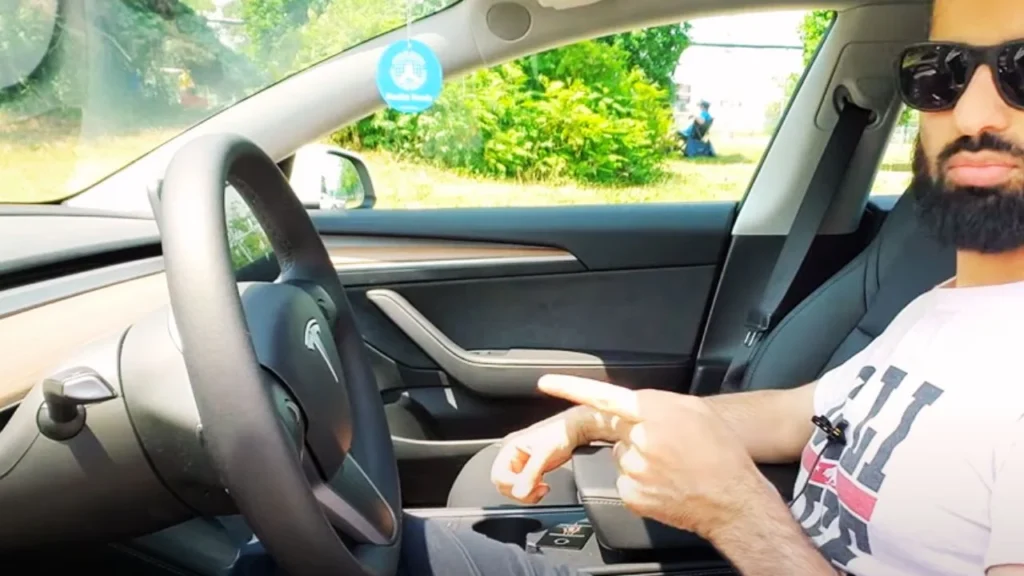
Alternatives to Jump Starting a Tesla
Sometimes jump-starting might not be the ideal option, so Tesla has a few alternatives to keep you moving. From Roadside Assistance to mobile service technicians, Tesla provides a range of support for 12-volt battery issues. Let’s explore how these options can be both convenient and cost-effective when a jump-start isn’t the best solution.
Tesla Roadside Assistance
When it comes to alternatives to jump-starting a Tesla, we actually have some handy options. First up is Tesla’s own Roadside Assistance, which can be a lifesaver, especially if you’re within their coverage. They’re available 24/7 and can tow you to the nearest service center or charging station, although this service is free only if your Tesla is still under warranty, which covers four years or up to 50,000 miles.
Tesla Mobile Service Technicians
Another option to consider is getting a mobile service technician from Tesla to come to you. If you’re dealing with a 12-volt battery that’s completely drained, these technicians can either jump-start or replace the battery on-site, making it much simpler. Replacing a 12V battery can cost around $150 if it’s not covered under warranty, but it’s often worth it to avoid future breakdowns.
Preventive Maintenance for Tesla Batteries
Lastly, if you’re the proactive type, there are preventive maintenance steps you can take. Regularly charging your Tesla to keep the 12-volt battery healthy is key, especially if you’re parking for extended periods. Also, keeping an eye on the battery health in your Tesla app can alert you weeks in advance if your battery needs attention, saving you from the hassle of jump-starting altogether.
Tesla Jump Start Safety Guide
Jump-starting a Tesla’s 12V battery comes with unique risks that are crucial to understand for safety. Here are some top safety considerations to protect your Tesla and ensure a smooth recovery:
- Use the Right Equipment: Only use a compatible lithium-ion jump-starter specifically for EVs to avoid damage to Tesla’s sensitive electronics.
- Avoid Prolonged Connections: Keeping the jump-starter connected for over 20 seconds can overheat systems; limit connection time.
- Skip Traditional Jumping Methods: Never use another car’s battery to jump-start a Tesla, as this can strain the 12V battery and cause electrical damage.
- Drive Gently Post-Jump: Once powered, avoid high-demand features to let the 12V battery recover steadily.
- Monitor for Issues: A quick range check post-jump can reveal if additional service might be needed for continued reliability.
Discover how Walmart assists with car jump-starts in our guide, Can Walmart Jump Start a Car?
Final Words
If you’re wondering, can you jump start a Tesla?—the answer is yes, with a few careful steps. By using an external power source and the right precautions, your Tesla’s 12V battery can get a boost in minutes. Regular maintenance is crucial, and even a quick 5-minute check now and then can prevent issues down the road. So, keep your Tesla’s battery in top shape, and enjoy a worry-free drive!
